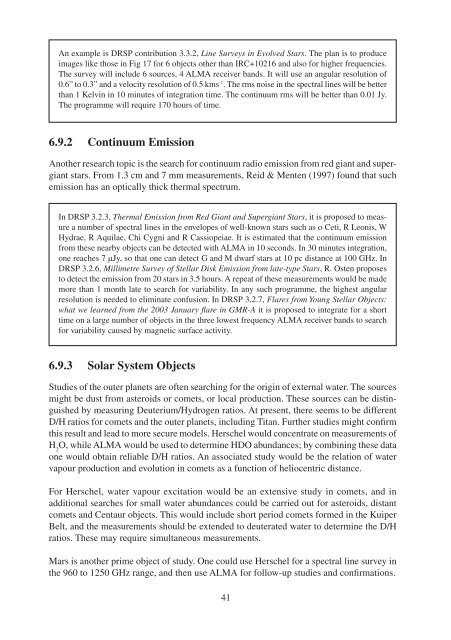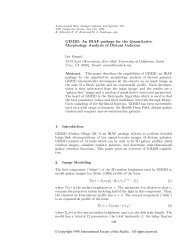4 Comparison of the ALMA and Herschel - ESO
4 Comparison of the ALMA and Herschel - ESO
4 Comparison of the ALMA and Herschel - ESO
Create successful ePaper yourself
Turn your PDF publications into a flip-book with our unique Google optimized e-Paper software.
An example is DRSP contribution 3.3.2, Line Surveys in Evolved Stars. The plan is to produce<br />
images like those in Fig 17 for 6 objects o<strong>the</strong>r than IRC+10216 <strong>and</strong> also for higher frequencies.<br />
The survey will include 6 sources, 4 <strong>ALMA</strong> receiver b<strong>and</strong>s. It will use an angular resolution <strong>of</strong><br />
0.6” to 0.3” <strong>and</strong> a velocity resolution <strong>of</strong> 0.5 kms -1 . The rms noise in <strong>the</strong> spectral lines will be better<br />
than 1 Kelvin in 10 minutes <strong>of</strong> integration time. The continuum rms will be better than 0.01 Jy.<br />
The programme will require 170 hours <strong>of</strong> time.<br />
6.9.2 Continuum Emission<br />
Ano<strong>the</strong>r research topic is <strong>the</strong> search for continuum radio emission from red giant <strong>and</strong> supergiant<br />
stars. From 1.3 cm <strong>and</strong> 7 mm measurements, Reid & Menten (1997) found that such<br />
emission has an optically thick <strong>the</strong>rmal spectrum.<br />
In DRSP 3.2.3, Thermal Emission from Red Giant <strong>and</strong> Supergiant Stars, it is proposed to measure<br />
a number <strong>of</strong> spectral lines in <strong>the</strong> envelopes <strong>of</strong> well-known stars such as ο Ceti, R Leonis, W<br />
Hydrae, R Aquilae, Chi Cygni <strong>and</strong> R Cassiopeiae. It is estimated that <strong>the</strong> continuum emission<br />
from <strong>the</strong>se nearby objects can be detected with <strong>ALMA</strong> in 10 seconds. In 30 minutes integration,<br />
one reaches 7 μJy, so that one can detect G <strong>and</strong> M dwarf stars at 10 pc distance at 100 GHz. In<br />
DRSP 3.2.6, Millimetre Survey <strong>of</strong> Stellar Disk Emission from late-type Stars, R. Osten proposes<br />
to detect <strong>the</strong> emission from 20 stars in 3.5 hours. A repeat <strong>of</strong> <strong>the</strong>se measurements would be made<br />
more than 1 month late to search for variability. In any such programme, <strong>the</strong> highest angular<br />
resolution is needed to eliminate confusion. In DRSP 3.2.7, Flares from Young Stellar Objects:<br />
what we learned from <strong>the</strong> 2003 January fl are in GMR-A it is proposed to integrate for a short<br />
time on a large number <strong>of</strong> objects in <strong>the</strong> three lowest frequency <strong>ALMA</strong> receiver b<strong>and</strong>s to search<br />
for variability caused by magnetic surface activity.<br />
6.9.3 Solar System Objects<br />
Studies <strong>of</strong> <strong>the</strong> outer planets are <strong>of</strong>ten searching for <strong>the</strong> origin <strong>of</strong> external water. The sources<br />
might be dust from asteroids or comets, or local production. These sources can be distinguished<br />
by measuring Deuterium/Hydrogen ratios. At present, <strong>the</strong>re seems to be different<br />
D/H ratios for comets <strong>and</strong> <strong>the</strong> outer planets, including Titan. Fur<strong>the</strong>r studies might confirm<br />
this result <strong>and</strong> lead to more secure models. <strong>Herschel</strong> would concentrate on measurements <strong>of</strong><br />
H 2<br />
O, while <strong>ALMA</strong> would be used to determine HDO abundances; by combining <strong>the</strong>se data<br />
one would obtain reliable D/H ratios. An associated study would be <strong>the</strong> relation <strong>of</strong> water<br />
vapour production <strong>and</strong> evolution in comets as a function <strong>of</strong> heliocentric distance.<br />
For <strong>Herschel</strong>, water vapour excitation would be an extensive study in comets, <strong>and</strong> in<br />
additional searches for small water abundances could be carried out for asteroids, distant<br />
comets <strong>and</strong> Centaur objects. This would include short period comets formed in <strong>the</strong> Kuiper<br />
Belt, <strong>and</strong> <strong>the</strong> measurements should be extended to deuterated water to determine <strong>the</strong> D/H<br />
ratios. These may require simultaneous measurements.<br />
Mars is ano<strong>the</strong>r prime object <strong>of</strong> study. One could use <strong>Herschel</strong> for a spectral line survey in<br />
<strong>the</strong> 960 to 1250 GHz range, <strong>and</strong> <strong>the</strong>n use <strong>ALMA</strong> for follow-up studies <strong>and</strong> confirmations.<br />
41




